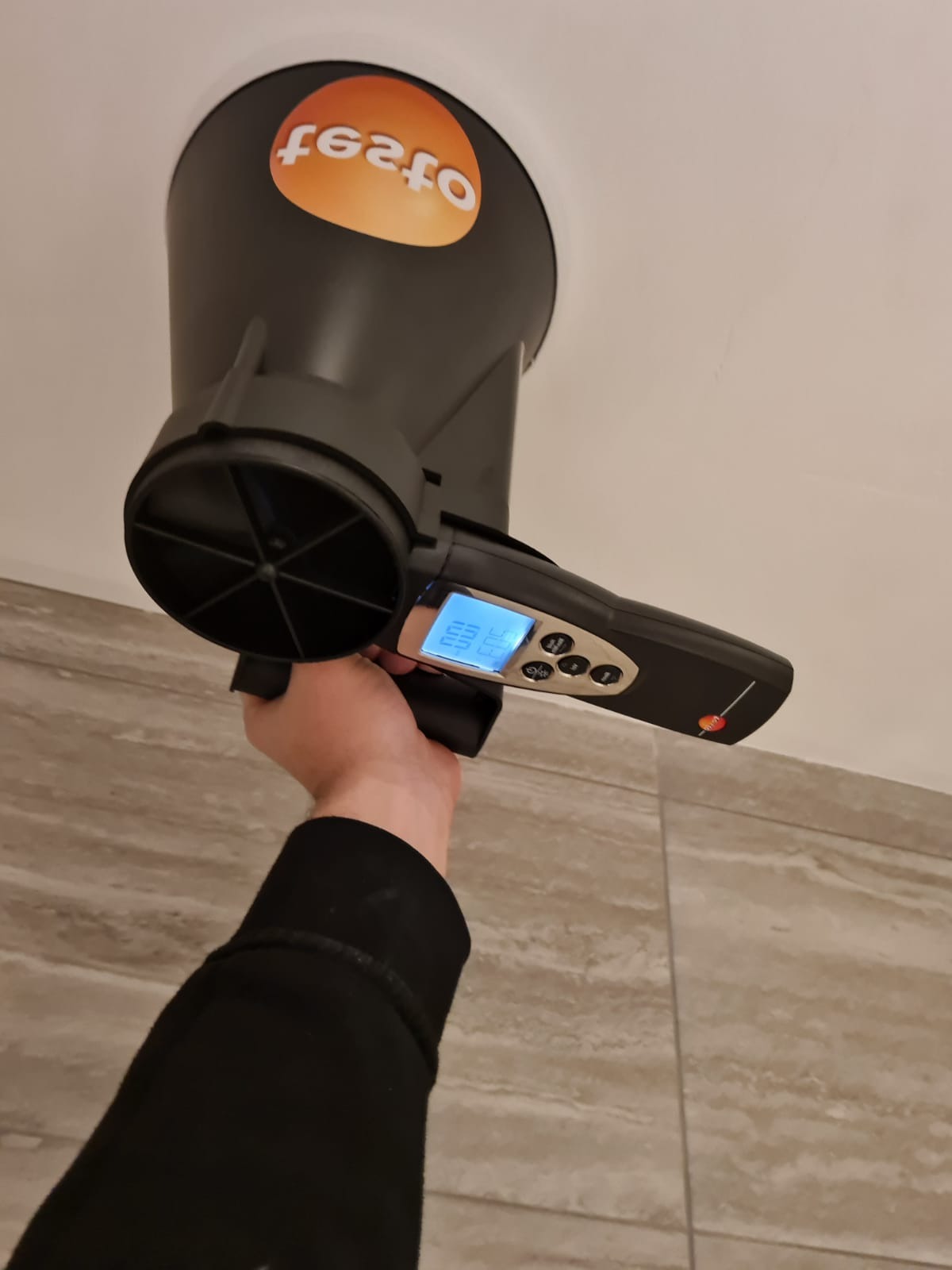
Technical Guide: Vent Testing
Building Compliance Testing Limited can provide you with a fast and cost effective Domestic Ventilation Commissioning and Air-flow Testing across the UK for Part F Building Regulation compliance.
 Ventilation Air-Flow Testing Technical Guide
Ventilation Air-Flow Testing Technical Guide
Welcome to our Ventilation Air-Flow Testing Technical Guide. In this comprehensive guide, we will provide you with a detailed understanding of ventilation air-flow testing, why it is essential, how it’s conducted, and its significance for maintaining optimal indoor air quality. Whether you are a homeowner, building manager, or HVAC professional, this guide will equip you with valuable insights into the principles of ventilation air-flow testing.
Table of Contents
Introduction to Ventilation Air-Flow Testing
- Defining ventilation air-flow testing
- The importance of indoor air quality
Why Ventilation Air-Flow Testing Is Necessary
- Impact on health and well-being
- Ensuring the efficient operation of HVAC systems
The Ventilation Air-Flow Testing Process
- Equipment and tools used
- Test standards and protocols
Interpreting Ventilation Air-Flow Test Results
- Understanding air-flow rates
- Identifying potential ventilation issues
Common Ventilation Air-Flow Problems
- Causes of inadequate ventilation
- Recognizing typical trouble spots
Improving Ventilation Air-Flow
- Air-flow enhancement techniques
- Retrofit options for older systems
When to Consider Ventilation Air-Flow Testing
- New construction
- Renovation and retrofit projects
- Periodic maintenance and system evaluation
Selecting a Certified Ventilation Air-Flow Testing Service
- Qualifications and accreditation
- Experience and expertise
Costs and Benefits of Ventilation Air-Flow Testing
- Cost considerations
- Long-term health and energy savings
Frequently Asked Questions (FAQs)
- Common inquiries and expert answers
Introduction
Ventilation air-flow testing is a critical aspect of maintaining healthy indoor air quality in homes, commercial buildings, and industrial spaces. It ensures that the ventilation system operates effectively, providing fresh air and expelling pollutants. In this guide, we will explore the various facets of ventilation air-flow testing, from the basics to the nuances of interpreting results, common problems, and improvement strategies.
Whether you are seeking information on how to optimize the performance of your HVAC system or want to understand how to enhance indoor air quality, this guide will provide the knowledge you need. We will also address when and how to consider ventilation air-flow testing, making it a valuable resource for all those invested in creating a safe and comfortable indoor environment.
2. Why Ventilation Air-Flow Testing Is Necessary
Impact on Health and Well-Being: Ventilation air-flow testing is crucial for ensuring that indoor spaces provide a healthy and comfortable environment. Proper ventilation helps reduce indoor air pollutants, control humidity, and prevent the buildup of harmful gases, safeguarding the well-being of occupants.
Ensuring the Efficient Operation of HVAC Systems: Adequate ventilation air-flow is essential for the efficient operation of heating, ventilation, and air conditioning (HVAC) systems. Testing helps identify issues that could lead to decreased HVAC performance, energy waste, and increased operational costs.
3. The Ventilation Air-Flow Testing Process
Equipment and Tools Used: Learn about the specialized equipment and instruments used in ventilation air-flow testing, including anemometers, manometers, and airflow hoods, and how they are employed to measure air-flow rates and assess ventilation system performance.
Test Standards and Protocols: Discover the established test standards and protocols that govern ventilation air-flow testing, ensuring consistency and reliability in assessments.
4. Interpreting Ventilation Air-Flow Test Results
Understanding Air-Flow Rates: Gain insights into air-flow rate measurements, air changes per hour (ACH), and other key parameters used to evaluate ventilation effectiveness. Learn how to interpret test results and assess whether a space meets air quality standards.
Identifying Potential Ventilation Issues: Understand how to identify potential issues with ventilation systems based on test results. Recognize common indicators of inadequate ventilation and their implications for indoor air quality.
5. Common Ventilation Air-Flow Problems
Causes of Inadequate Ventilation: Explore the common factors that lead to inadequate ventilation, such as system design flaws, blockages, or improper maintenance.
Recognizing Typical Trouble Spots: Learn about the areas within ventilation systems where problems often occur, including ductwork, filters, fans, and exhaust outlets.
6. Improving Ventilation Air-Flow
Air-Flow Enhancement Techniques: Discover various techniques and strategies for improving ventilation air-flow, from adjusting system settings to modifying components or upgrading equipment.
Retrofit Options for Older Systems: Explore retrofit options for older buildings or systems to enhance ventilation performance and indoor air quality.
7. When to Consider Ventilation Air-Flow Testing
New Construction: Find out why ventilation air-flow testing is essential for new construction projects to ensure that HVAC systems are designed and installed correctly from the outset.
Renovation and Retrofit Projects: Understand the benefits of incorporating ventilation air-flow testing during renovation and retrofit projects to optimize existing systems and meet modern air quality standards.
Periodic Maintenance and System Evaluation: Learn why regular maintenance and system evaluation, including air-flow testing, are essential for maintaining indoor air quality and the efficient operation of HVAC systems.
8. Selecting a Certified Ventilation Air-Flow Testing Service
Qualifications and Accreditation: Understand the qualifications and accreditations to look for when selecting a ventilation air-flow testing service provider to ensure reliable and accurate results.
Experience and Expertise: Evaluate the importance of experience and expertise in delivering high-quality ventilation air-flow testing services.
9. Costs and Benefits of Ventilation Air-Flow Testing
Cost Considerations: Explore the factors that influence the cost of ventilation air-flow testing and how this investment can translate into long-term energy savings and improved health.
Long-Term Health and Energy Savings: Discover the potential long-term benefits of ventilation air-flow testing, including energy savings, improved indoor air quality, and occupant well-being.
10. Frequently Asked Questions (FAQs)
- Common Inquiries and Expert Answers: Access a comprehensive list of frequently asked questions about ventilation air-flow testing, complete with expert answers to provide clarity on this vital aspect of indoor air quality and HVAC system performance.
Feel free to navigate through the sections that interest you the most or start from the beginning to gain a comprehensive understanding of ventilation air-flow testing and its significance for indoor air quality and HVAC system efficiency. If you have specific questions or need personalized guidance, our experts at Building Compliance Testing are ready to assist you in achieving superior indoor air quality and optimizing your ventilation systems.
Frequently Asked Questions
What Ventilation System have I got installed, and why?
- If your dwelling has extractors within sanitary areas, wet areas and the kitchen that operate
intermittently, or is triggered by a light, PIR or humidity switch and has trickle vents installed in your
external windows, it is likely you have a System 1 Intermittent Extract and Natural Ventilation. A System 1 is
designed with an Air Tightness greater than >4.00m-3.h.m-2 at 50 Pascals to operate efficiently. - If your dwelling has extractors within sanitary areas, wet areas and the kitchen that operate
continuously and has trickle vents installed in your external windows, it is likely you have a System 3
Mechanical Extract Ventilation. A System 3 is designed with an Air Tightness <4.00m-3.h.m-2 at 50
Pascals to operate efficiently. - If your dwelling has ventilator terminals in all rooms and has a central controller unit, and no trickle vents,
it is likely you have a System 4 Mechanical Extract with Heat Recovery Ventilation. A whole dwelling
ventilation system is designed with an Air Tightness <3.00m-3.h.m-2 at 50 Pascals to operate efficiently. - It should be noted the lower the dwellings Air Tightness, the less uncontrolled/ natural ventilation there
will be and as such the less unwanted heat loss however the air change rates will reduce, hence the
need for a Mechanical Extract and Heat Recovery Ventilation System.
How do I prepare for a Ventilation Test?
Check what fans you are buying and for what use. For instants extractors within cooking spaces require.
We’re friendly and knowledgeable bunch so why not get in touch for a chat. You can always contact Building Compliance Testing with any questions through phone, email or our online chat service.
Don’t worry, we don’t charge for advice given over the phone, so why not ask for a free quote?
01621 493 594 | contact@buildingcompliancetesting.com
Let's Talk About Your Project?
Questions? We've Got Answers!
Find below a list of common frequently asked questions about Air Permeability Testing.

